How to Visit Alaska National Parks
Last Updated on December 14, 2024
Alaska is home to 8 National Parks as well as many other Federal and State public lands. More than half of all National Park Service land is located in Alaska. The 8 National Parks in Alaska are double the size of all the National Parks in the Lower 48 COMBINED. Alaska National Parks are huge, stunningly beautiful and a little extra work to get to. That’s why you’re here! In this article you’ll learn all about how to choose which Alaska National Parks you want to visit and everything you need to know to make it happen.
I lived in Alaska for 7 years and have visited most of the national parks in Alaska (including the super remote Gates of the Arctic National Park) and my husband worked for the park service in Alaska for several years, so I’m the perfect guide to telling you everything you really need to know to visit Alaska’s national parks!
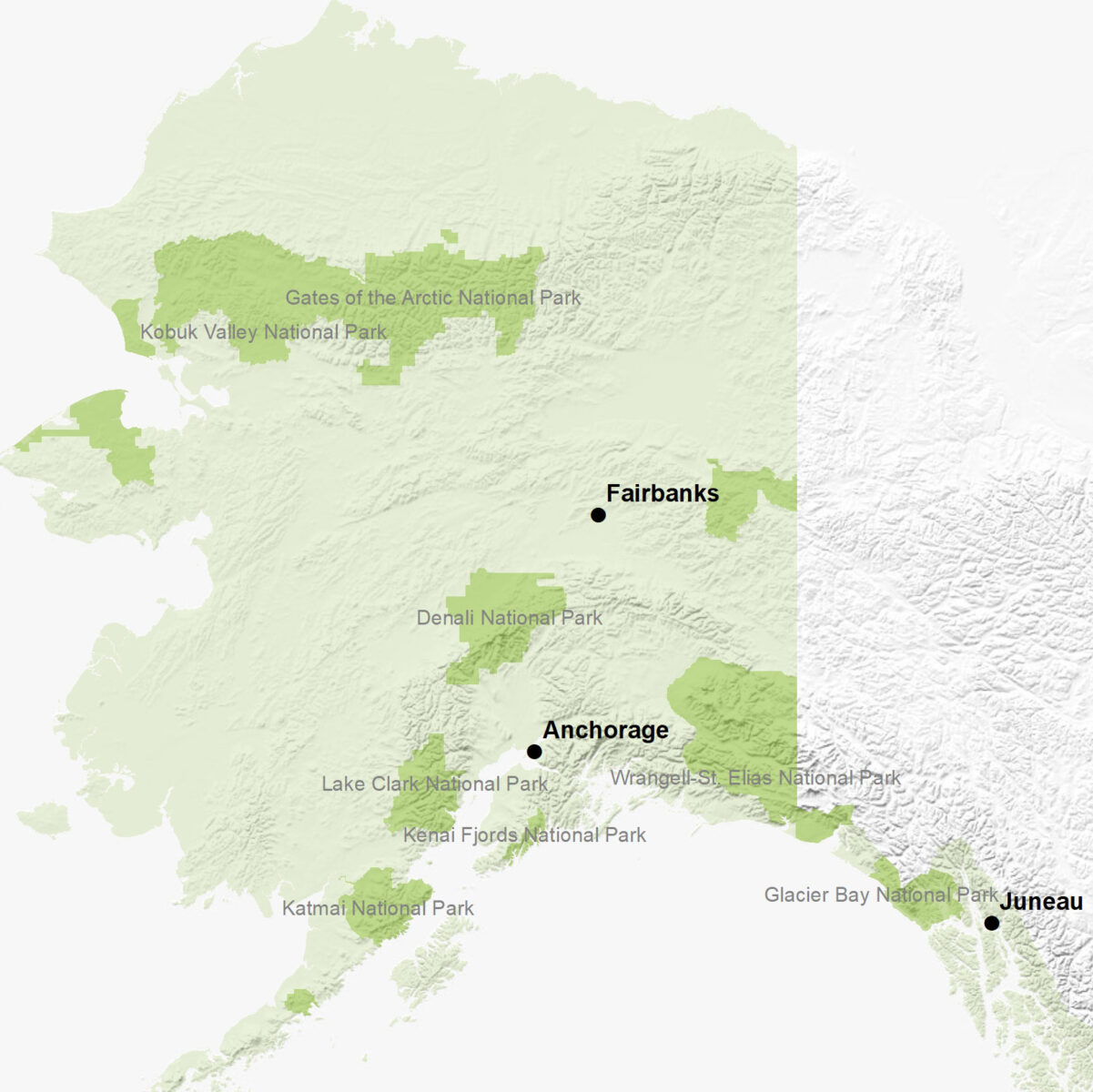
Cartography Credit: Jay Flaming
The Alaska Public Lands Information Centers are a fantastic resource and a fun and informational stop on your way to visit Alaska national parks. They are staffed by knowledgeable and friendly folks who can answer questions and help you with resources like maps and campgrounds. These centers are located in Anchorage, Fairbanks, Ketchikan and Tok (along the Alaska Highway).
After covering the basics, this article is organized from Alaska national parks that are easiest to get to to the ones that are hardest to get to. I’ve also included a sample itinerary for each park. I don’t recommend trying to visit every Alaska National Park in one trip unless you have a lot of time and really like to move around A LOT. If that’s the case, go for it and put them all together!
Let’s get started!
Prefer to listen to how to plan your Alaska National Parks trip?
I’m the host of the Alaska Uncovered Podcast and we have lots of episodes about visiting Alaska National Parks.
Related: Guide to planning a trip to Alaska, Alaska on a Budget
- Which Alaska national parks can you drive to?
- How to visit all Alaska National Parks
- Weather and Seasons in Alaska national parks
- Why travel insurance is important for visiting Alaska National Parks
- Camping and hiking with bears
- Denali National Park and Preserve
- Kenai Fjords National Park
- Glacier Bay National Park and Preserve
- Wrangell-St Elias National Park and Preserve
- Katmai National Park and Preserve
- Lake Clark National Park and Preserve
- Gates of the Arctic National Park and Preserve
- Kobuk Valley National Park and Preserve
Which Alaska National Parks can you drive to?
If you are trying to visit every national park in Alaska, you’ll need at LEAST a month to make that happen. That type of trip requires many flights, boats and lots of logistics so I would encourage you to prioritize and not try to see them all in one trip. If you’re game for that level of travel though, then go for it! If you’re up for that, you might be thinking about bringing your own car to Alaska and if so, read my complete guide to driving to Alaska here.
Three of the eight Alaska national parks are accessible by road and you can drive to: Denali National Park, Kenai Fjords National Park and Wrangell-St Elias National Park. Wrangell-St Elias requires a long drive on a gravel road. Denali and Kenai Fjords are also accessible by bus and train.
Glacier Bay National Park is accessible by cruise ship and ferry in addition to small planes and sometimes commercial jets.
Lake Clark National Park, Katmai National Park, Gates of the Arctic National Park and Kobuk Valley National Park are only accessible by small plane, usually a float plane that lands on the water.
How to visit all Alaska National Parks
In my opinion, the best way to visit all Alaska National Parks is to split it up into multiple trips. If you try to visit all 8 in one trip it’s really exhausting and you’re moving around all the time. If that sounds like what you want to do, however, absolutely go for it. You can put the itineraries below into one big mega itinerary!
Kobuk Valley and Gates of the Arctic go together well in one trip because you can see both in a flightseeing trip from Kotzebue.
Denali, Kenai Fjords and Wrangell St-Elias fit well together because you can drive to them all based out of Anchorage or Fairbanks. Wrangell St-Elias involves a long drive on a gravel road that you can’t take most rental cars on, but you can also fly there.
Katmai and Lake Clark fit well together because you can visit them both in day trips from Anchorage, Homer, or Kodiak or you can go to one of the remote fly in lodges to get more time.
Finally, Glacier Bay works best on its own, since it’s in a different part of Alaska (Southeast) so it fits well into a trip combined with Juneau, Haines or Skagway.
By the way, in addition to the 8 National Parks with that designation, there are many other federal public lands in Alaska including two National Historical Parks and four National Preserves. This article focuses on the eight national parks, but there are many other public lands to explore in the vast state of Alaska.
Looking for an Alaska National Parks expert to help you plan your trip? Let me help! I offer 30 minute planning sessions and custom itineraries to make it happen.
Weather and Seasons in Alaska National Parks
Generally speaking, Alaska national parks are best visited in summer. More details about the best time to visit each one is below. A few things to note about weather and seasons in Alaska:
- Weather varies greatly throughout Alaska in both summer and winter
- Weather is highly variable everywhere in Alaska – summer days can be quite hot but can also be chilly and rainy. You’ll need to be prepared for both!
- Weather can cause delays and cancellations in small plane aviation – visibility and wind can create times when small planes cannot fly. If you’re doing to a park requiring a flight in (Gates of the Arctic, Kobuk Valley, Lake Clark and Katmai) make sure you build extra days into your itinerary to account for this.
- Mosquitoes are intense throughout Alaska in the summer. Read more here about dealing with mosquitoes while hiking and camping
- It does not get dark in summer in Alaska – from late May through July it will be daylight all or most of the time. While parks above the arctic circle such as Gates of the Arctic and Kobuk Valley will have the sun above the horizon 24 hours a day, ones further south such as Glacier Bay will have only a couple hours of darkness.
- Seeing the Northern Lights – if you have your heart set on seeing the Northern Lights on your trip to Alaska, visit in late August or September. There are also fewer or possibly zero bugs during this time! Denali is a particularly good park to visit if you’re hoping to catch the northern lights on your trip (only at the end of the season – late August and early September).
- Late August and September are fall in Alaska, not summer – the later in the season you visit, the more you need to be ready for snow and freezing temperatures, especially at night and especially the further north or inland you are. Late August and September are more likely to be early winter in the arctic.
- Denali National Park is the only Alaska National Park you can visit in winter. For adventurers who love solitude and winter, this might be for you! Read my full guide to Denali in winter here.
Related: What to pack for Alaska
Why Travel Insurance is important for a trip to Alaska National Parks
This post contains affiliate links, which means if you make a purchase I may receive a small commission at no additional cost to you.
Travel insurance is not the most exciting subject, but it’s an important consideration when traveling to remote areas of Alaska, especially if you’re going to be traveling by small plane, which is particularly prone to frequent weather delays and cancellations.
I always have travel insurance when I go to Alaska if I’m booking anything non refundable (remote lodges, small plane flights, etc). I like to use Insure My Trip (This is an affiliate link, which means if you make a purchase I may receive a small commission at no additional cost to you) because you can compare prices from different travel insurance companies and search based on the features you need in your plan instead of what a single company offers.
You’ll need to evaluate your activities, your costs and your personal financial situation to determine if travel insurance makes sense for you for your trip, but I want to encourage you to consider it! It’s usually quite affordable for a lot of peace of mind.
I also encourage folks to find out what’s already covered in their health insurance and with their credit cards and any other insurance you are part of before buying travel insurance.
Camping and Hiking with Bears
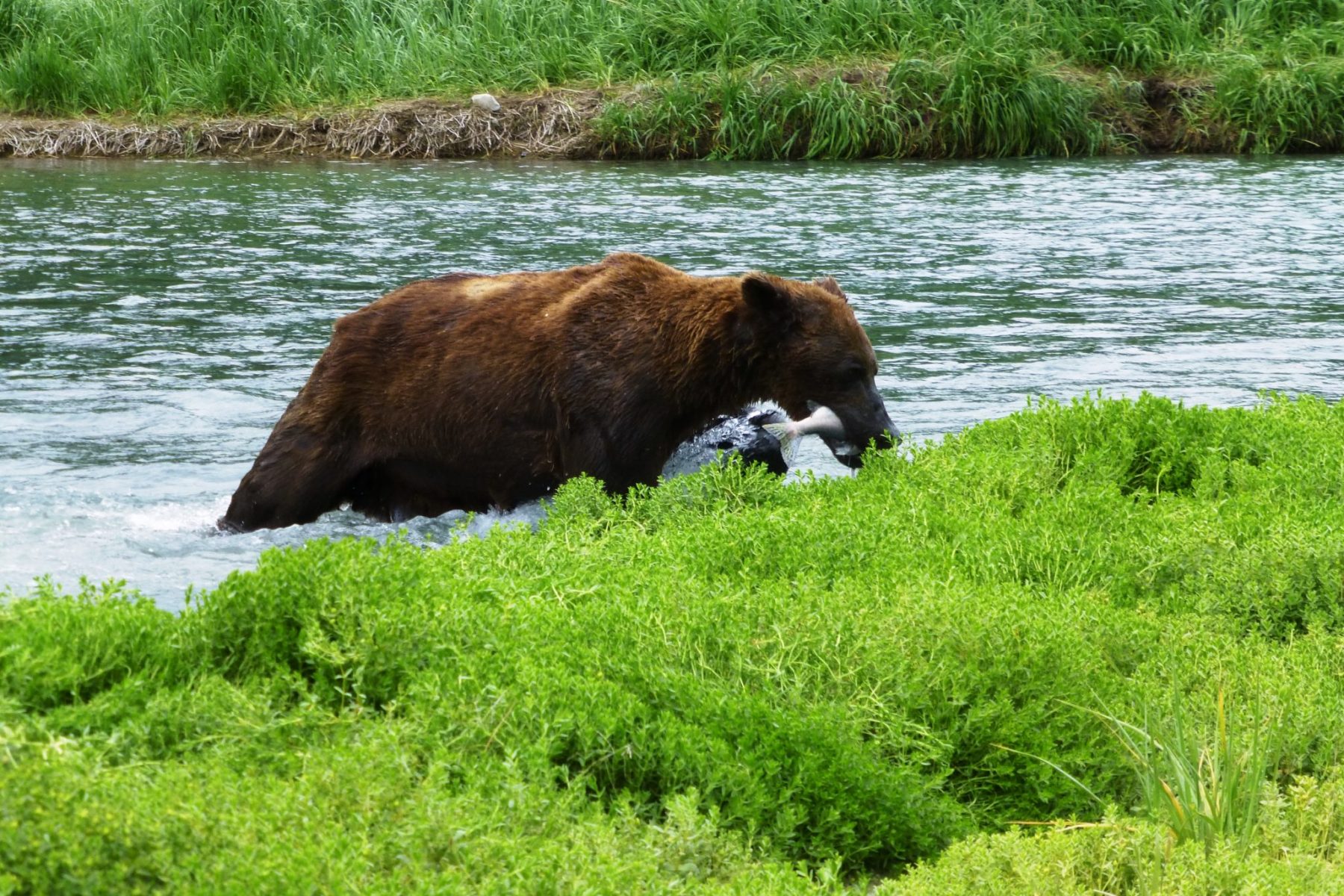
Photo Credit: Jamie Volz
Black bears and brown bears are both present in large numbers in all Alaska national parks. It is imperative that you take bear safety seriously and follow all rules and recommendations put in place by the park service. This is for your safety as well as the safety and protection of the bears. Exact regulations vary from place to place but some general guidelines include:
- Carry bear spray – similar to pepper spray, if a bear attacks you can defend yourself in a non lethal way. Note that bear spray can not be carried on airplanes
- Respect all trail, campground and other area closures – if an area has been closed due to bear activity, do not enter it
- Never approach or feed bears, ever
- Never store food, cooking equipment, toiletries or anything else with a scent in or near your tent. These items should always be in a bear cache or locker or bear bin (these details vary by the system each park has set up for bear safe storage). Never leave these items unattended for any amount of time.
- Never run from a bear
Related: How to fly with camping gear, Complete Guide to Camping in Alaska
Denali National Park and Preserve
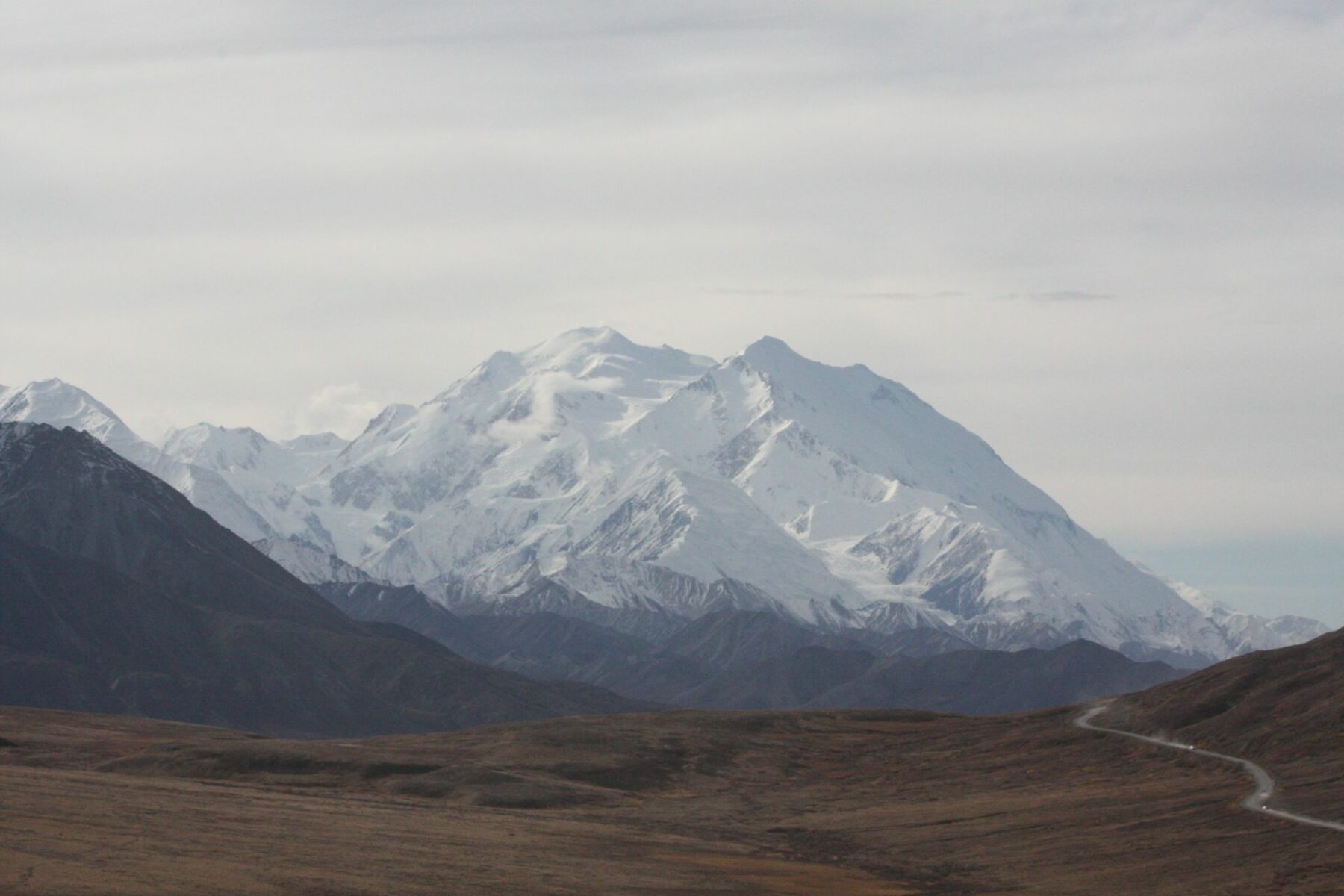
Photo Credit: Jamie Volz
2025 Note: The Denali Park Road closed at Milepost 42 (Polychrome Pass) in August 2021. The park service has announced that the road will remain closed at this point at least through the 2025 season. A permanent fix to this section of road is currently being built. Bus tours will still operate up to that point. Eielson Visitor Center and Wonder Lake will not be accessible.
Denali National Park and Preserve is a treasured Alaska National Park and one that many visitors from around the world dream of visiting in their lifetime! It is also one of the easiest Alaska National Parks for an independent traveler to get to.
Denali is the homeland of the Koyukon and Dena’ina Athabaskan people.
I have a full guide to planning your dream trip to Denali National Park here, as well as a guide to the Denali Road Lottery.
Getting to Denali National Park
Denali National Park is one of the three Alaska National Parks you can drive to. You can also get there by train or bus.
The closest major airports to Denali National Park are Anchorage and Fairbanks. Both have many car rental options. Anchorage is a four hour drive from Denali and Fairbanks is a two hour drive.
You can also take the Alaska Railroad from either Anchorage or Fairbanks for a car free experience, or a motorcoach from Anchorage.
Denali National Park has a $15 per person entrance fee.
When is the best time to visit Denali?
Denali National Park is open all year, though winters are extremely cold (well below zero) and most things are closed, including hotels and restaurants.
Everything in Denali is open from mid May until early September, including the park buses, tours, visitor center, hotels and restaurants. July and August are the busiest times in Denali and the most expensive for lodging.
In my opinion, late May and early June are the best times for an independent traveler to visit Denali. I also think early September is a wonderful time with the gorgeous fall color in the tundra with less bugs. If you go in early September, be ready for it to be cold, wet and possibly snowing!
Camping and Lodging in Denali National Park
Denali has six campgrounds. Two are accessible by car or RV and open to tents and RVs. Four, including Wonder Lake with it’s stunning view of Denali itself, are only accessible by the camper bus. Camping in Denali is $17-$34 per night, depending on the campground and the size of the campsite. Riley Creek Campground, near the park entrance, is open year round (and free in winter).
There are many lodges and hotels around the park entrance and nearby Healy. Book as early as possible. Lodging in Denali is expensive. If you’re prepared to not feel like you’re getting your money’s worth and that you’re paying for the location, you’ll be much happier! Lodging is noticeably less expensive early and late in the season
You can also get a backcountry permit for backpacking in other remote parts of the park. Talk to the rangers about your options!
Denali Highlights
- Epic Alaska Landscapes – no matter where you go in Denali, you will be treated to epic mountain and river scenery!
- Wildlife – Denali is one of the best National Parks for seeing wildlife. I have been there many, many times and have seen multiple bears on every visit (unless it was winter or early spring). To improve your chances of seeing bears, ride the bus into the park as long as you can!
- Hiking – from spectacular Mt Healy near the park entrance, to the mellow walk along the Savage River, to hiking on the trail free tundra, there are nearly endless trails to explore in Denali
- Bus Trip into the park – You can not drive beyond the 15 mile mark into Denali National Park. Beyond here you need to take a narrated tour, hiker shuttle or camper shuttle into the park. I recommend going at least as far as the Eielson Visitor Center for amazing views of Denali and lots of wildlife opportunities. Read more about your bus options in my complete guide linked above.
- Dog Kennels – Denali’s working dog teams do demonstrations in the summer. Don’t miss this, it’s such a unique thing to do in a national park!
Special Considerations for Denali
Denali National Park does not allow private cars into most of the park. You will need to take a shuttle bus or narrated tour to get deep in the park (don’t miss this! It’s wonderful). It’s a different experience than buses in other parks so I recommend learning all about your options in my guide or on the park service’s website.
There are no services, food, restaurants, or gas in Denali National Park. You must bring your own food and water with you. There is a small store at the park entrance and plenty of food available outside the park.
Sample 3 day Itinerary for Denali
- Day 1: Arrive and check into your hotel or set up your camp. Visit the sled dog kennels and visitor center and explore either the Savage River Trail or the Mt Healy overlook hike
- Day 2: Take the bus tour or hiker shuttle into the park for wildlife viewing and exploring
- Day 3: Go for a zipline or rafting trip, or do more hiking around the entrance area
- If you have more time: go backpacking or camping further in the park, or more hiking!
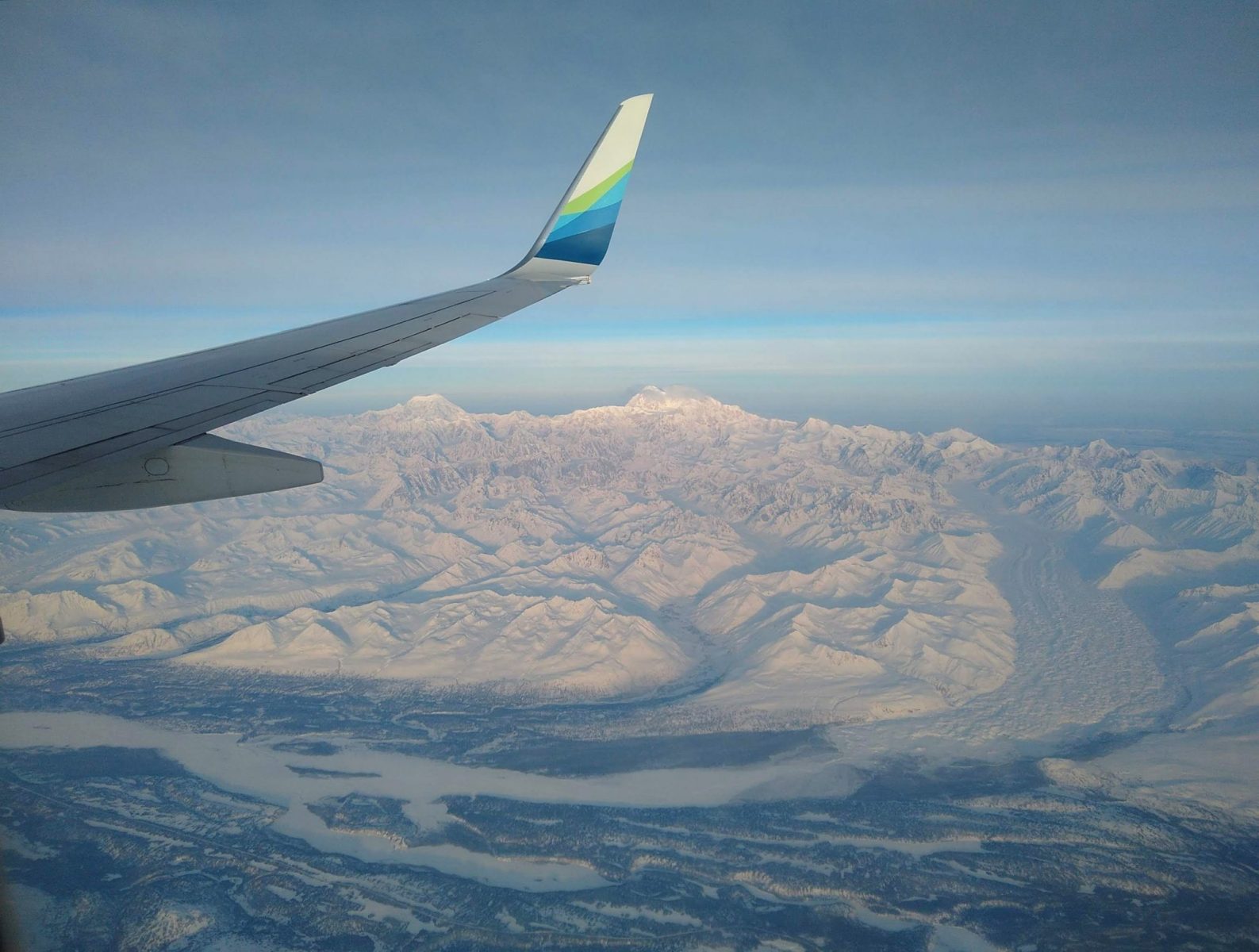
Kenai Fjords National Park
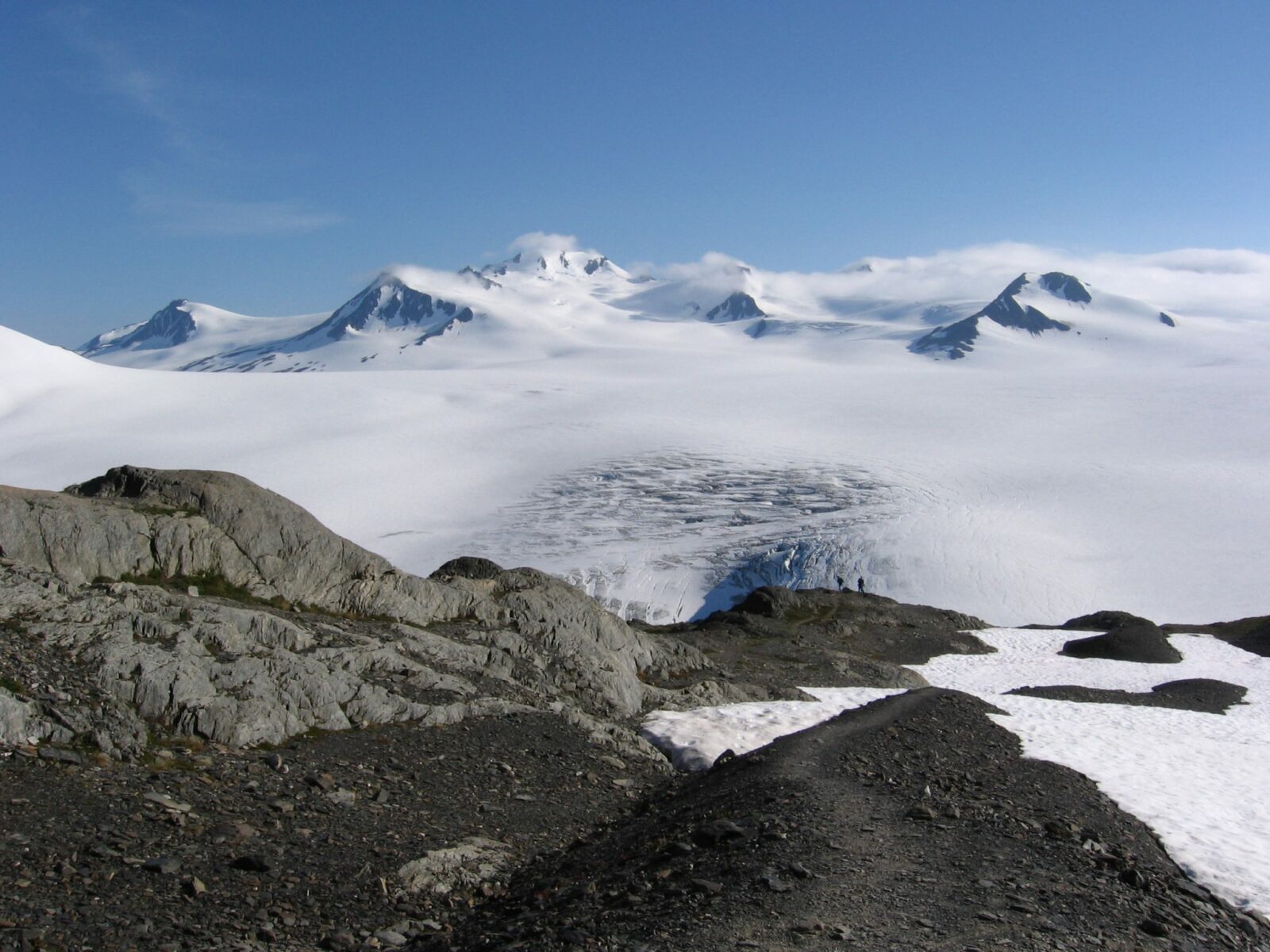
Photo Credit: Jamie Volz
Another of the three Alaska national parks you can drive to, Kenai Fjords is an impressive expanse of mountains, glaciers, fjords and wildlife. Less than three hours from Anchorage by car you can explore this park by water and land, based from the town of Seward. You can even travel here without a car by taking the absurdly scenic Alaska Railroad for just over four hours from Anchorage to Seward.
Kenai Fjords is the homeland of the Dena’ina and Alutiiq people.
Getting to Kenai Fjords National Park
Compared to most Alaska national parks, Kenai Fjords is straightforward to get to. From Anchorage you can drive or take a bus or train to the gateway town of Seward.
The boat tours and water taxis into the park depart from Seward, and the Exit Glacier and Harding Ice Field trailhead are 12 miles from town.
There is no entrance fee for Kenai Fjords National Park.
When is the best time to visit Kenai Fjords?
Summer is the best time to visit Kenai Fjords, when you can take the spectacular boat tour, kayak and hike around the park.
This park is more visitable in the shoulder season than many other Alaska national parks. If you like to avoid crowds, consider a May visit!
Camping and Lodging in Kenai Fjords
There is a small first come first served walk in campground at Exit Glacier. This campground has two ADA accessible campsites. There are also campgrounds in nearby Chugach National Forest and in Seward.
There are two public use cabins in Kenai Fjords that you can access by water taxi only and must be reserved (reservations open January 1st each year).
Backcountry camping is an option in the park, including kayak camping. The national park service does not recommend kayaking from Seward into the park because of rough conditions and a lack of good landing sites. Reserve a water taxi to take you to the area you want to camp or paddle in and have them drop you off and go from there.
There are several lodges accessible by boat only within Kenai Fjords. There are also plenty of lodging options in Seward.
Kenai Fjords Highlights
- Day boat tour – if you only do one thing in Kenai Fjords, make it this day tour! Departing from Seward, you’ll get to see the incredible mountains and glaciers, including tidewater glaciers that crash into the ocean! There is also an abundance of wildlife, including whales, sea otters, seabirds and other sea mammals. There are also moose and bears you may see along the shore.
- Hike the Harding Ice Field trail – this strenuous trail is just over 8 miles round trip with nearly 4000 feet of elevation gain. Along the way you’ll see Exit glacier which comes down from the Harding ice field (along with nearly 40 other glaciers!). Wildlife, wildflowers and incredible scenery round out this gorgeous hike.
- Exit Glacier – an alternative to the strenous hike, the mellow trails and nature center will help you learn about the ice and glaciers of Kenai Fjords. There is an ADA accessible trail here to a viewpoint of Exit Glacier. Ranger programs are available here as well.
- Kayaking – get dropped off by a water taxi for a backcountry camping and kayak experience, or take a guided trip
Special Considerations for Kenai Fjords
Make sure to make reservations and arrangements ahead of time for boat tours, water taxis and lodging in this area. Kenai Fjords has a maritime climate, so be ready for chilly and rainy days even during the summer.
Groceries, restaurants and service are available in Seward, but not inside the park.
Sample 3 day Itinerary for Kenai Fjords
- Day 1: Arrive and check into your hotel or set up your camp. Go on a kayaking tour out of Seward
- Day 2: Take the boat tour into the park to see wildlife and glaciers
- Day 3: Explore the Exit Glacier area and if you’re up for hard hikes, do the Harding Icefield Trail
- If you have more time: Seward is a great town to explore and is wonderful for fishing. You can also do multi day kayak trips in the park
Learn more: The best things to do in Kenai Fjords National Park
Glacier Bay National Park and Preserve
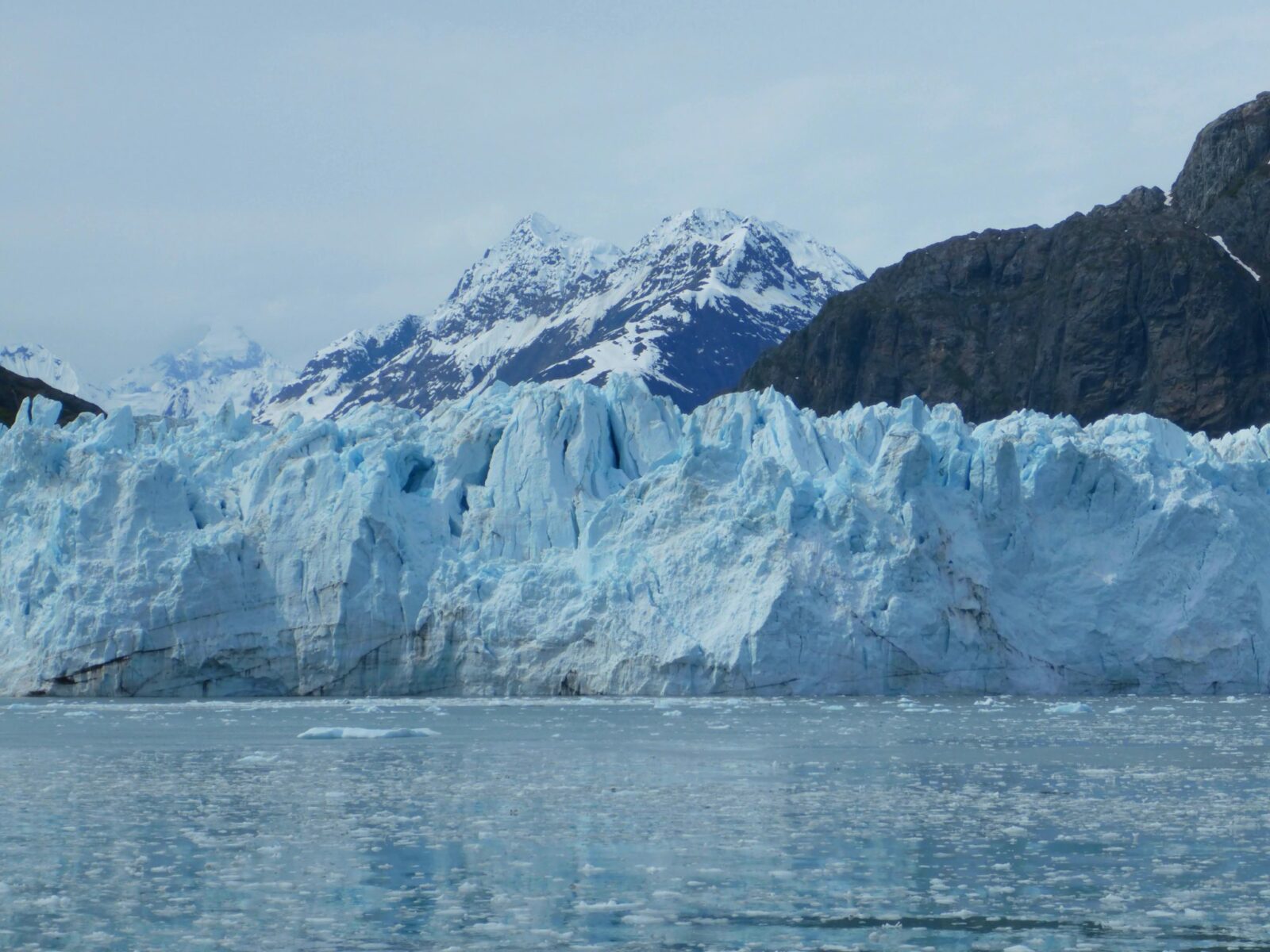
Glacier Bay is the most visited Alaska National Park, but nearly all of those visitors arrive on a cruise ship. As an independent traveler, you will find only a small number of others exploring this magical park. Glacier Bay National Park is my personal favorite Alaska National Park and one of my favorite places in all of Alaska! Read my complete guide to visiting Glacier Bay for independent travelers here.
Glacier Bay National Park is the home of the Huna Tlingit people. Don’t miss the chance to meet Huna Tlingit cultural interpreters when visiting the park (details below).
Getting to Glacier Bay National Park and Preserve
Glacier Bay National Park is remote and not accessible by road. There are three ways to get to Glacier Bay:
- On a cruise ship – if Glacier Bay is on your bucket list make sure your cruise ship itinerary stops here! Many cruise ship itineraries traveling the Inside Passage call at Glacier Bay but not all.
- By Ferry – You can take the Alaska ferry from Juneau to Gustavus several days a week and then take the lodge bus or a taxi from the ferry dock to the park (10 miles)
- By Plane – Alaska Airlines flies to Gustavus daily for a couple months in the summer from Juneau. Year round air service is available on small planes from Juneau. From the airport in Gustavus you can take the lodge bus or a taxi to the park (10 miles)
There is no entrance fee for Glacier Bay National Park.
When is the best time to visit Glacier Bay?
You can visit Glacier Bay from Memorial Day until Labor Day (late May through early September) when the lodge is open and the day boat tour is operating.
I recommend coming early in the season, very end of May and beginning of June, when the park is least crowded and least rainy (it can still be very rainy! you need to be prepared for rain at all times of year here). Early summer has less rain than later in the summer. Tours and lodging are also less booked in early season.
Camping and Lodging in Glacier Bay
Camping is free at the wonderful Bartlett Cove Campground. You need to get a permit from the rangers but space is not a problem. There are also bear caches for storing food and toiletries, water, composting toilets and you can even take showers and do laundry (for a fee) in the lodge!
You can get a backcountry permit from the rangers to camp in the backcountry. Kayak camping is popular in the park and you can also get dropped off with or without a kayak by the day boat in different parts of the park.
The Glacier Bay Lodge is located in Bartlett Cove. There are also lodges available in Gustavus. I recommend staying in the park if you’re an independent traveler, since Gustavus is 10 miles from the park.
Glacier Bay National Park Highlights
- Day Boat Tour – It’s expensive ($225-$240 per person) but it’s totally worth it. This is one of the very best tours in Alaska! See glaciers and wildlife and if the weather cooperates, amazing mountain vistas.
- Visit the Huna Tribal House – learn about Tlingit cultural from Huna Tlingit Cultural Interpreters and see the beautiful artistry of the building itself
- Hiking around Bartlett Cove – there are several trails leaving from the lodge
- Tidepooling – Glacier Bay’s beaches have spectacular tidepools!
- Kayaking – you can rent kayaks or take a half or full day tour around the Beardslee Islands
- Wildlife – Glacier Bay is a wonderful place for wildlife. Seals and whales are often available from the shore along with bears.
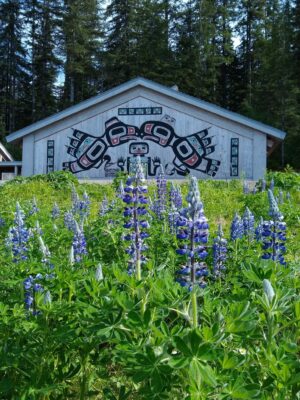
Special Considerations for Glacier Bay
The glaciers are not visible from Bartlett Cove. To see the spectacular glaciers, you’ll need to take the Day Boat to the head of the bay. Highly recommended!
You cannot bring in bear spray or camping fuel on an airplane. If you want to bring these with you from Juneau, you’ll need to take the ferry to Gustavus instead of flying. You can also get these items in Gustavus and sometimes you can take ones that have been left behind by others in the cache near the Bartlett Cove Ranger Station.
There are no groceries available in Bartlett Cove. The restaurant at the Lodge is the only food available. Limited food options are available in Gustavus (10 miles away).
Sample 4 day Itinerary for Glacier Bay
- Day 1: Ferry or Fly from Juneau to Gustavus. Get settled in the campground or lodge. Take a walk on the beach and/or along the Forest trail
- Day 2: Day Boat Tour and visit the Huna Tribal House
- Day 3: Half or full day kayak trip
- Day 4: Hike Bartlett River Trail or the beach, ferry or fly back to Juneau in the afternoon
Learn more: Complete guide to visiting Glacier Bay National Park
Wrangell – St Elias National Park and Preserve

Wrangell-St Elias is the largest national park in the United States! In addition to being huge, it also includes 9 of the 16 highest peaks in the United States. It goes from glacier kissed ocean to over 18,000 feet at the top of Mt St Elias. When you fly from Seattle to Anchorage, sit on the right (left going south) and if it’s clear you’ll see Mt St Elias and many other high peaks. You’ll be flying over the park for about half an hour!
Bordering Canada’s Kluane National Park, this internationally protected area is home to the largest collection of glaciers and the greatest cluster of peaks over 16,000 feet high in North America. Mountains, glaciers, wildlife, wilderness. There just aren’t enough statistics and superlatives to put this park into words. You’ll just have to go!
Wrangell-St Elias National Park is the homeland of the Ahtna People.
Getting to Wrangell-St Elias National Park and Preserve
Wrangell-St Elias National Park is one of the three Alaska national parks you can drive to. Make certain that your rental car company allows driving on gravel roads (many do not). Make sure you have tire changing equipment and a spare, as gravel roads lead to more frequent flat tires. The national park service recommends that those with RVs do NOT drive on the park road.
The McCarthy road is remote and gravel and a slow but incredibly scenic drive! Plan on the drive taking at least three hours for the 60 mile drive from Chitna each way. Make sure to bring food and water with you. There are a couple of food options in tiny McCarthy and a dining room at the Kennicott Glacier Lodge. Otherwise there are no services and no gas.
If you don’t want to take on driving on the gravel road there are plenty of tours you can take as day trips or multi day adventures, to get you into the park! You can also fly in on a small plane.
In the summer there is a shuttle between McCarthy and the Kennecott Mine Historic site which are about 5 miles apart.
Read more about all your options for getting to McCarthy here.
There is no entrance fee to visit Wrangell-St Elias.
When is the best time to visit Wrangell-St Elias?
The park is open all year, but the best time for visitors is June through mid September. During this time, facilities are open for visitors and the road is maintained.
Early in the season there will be more mosquitoes, later in the season more cold weather. July is the most ideal time to visit this park.
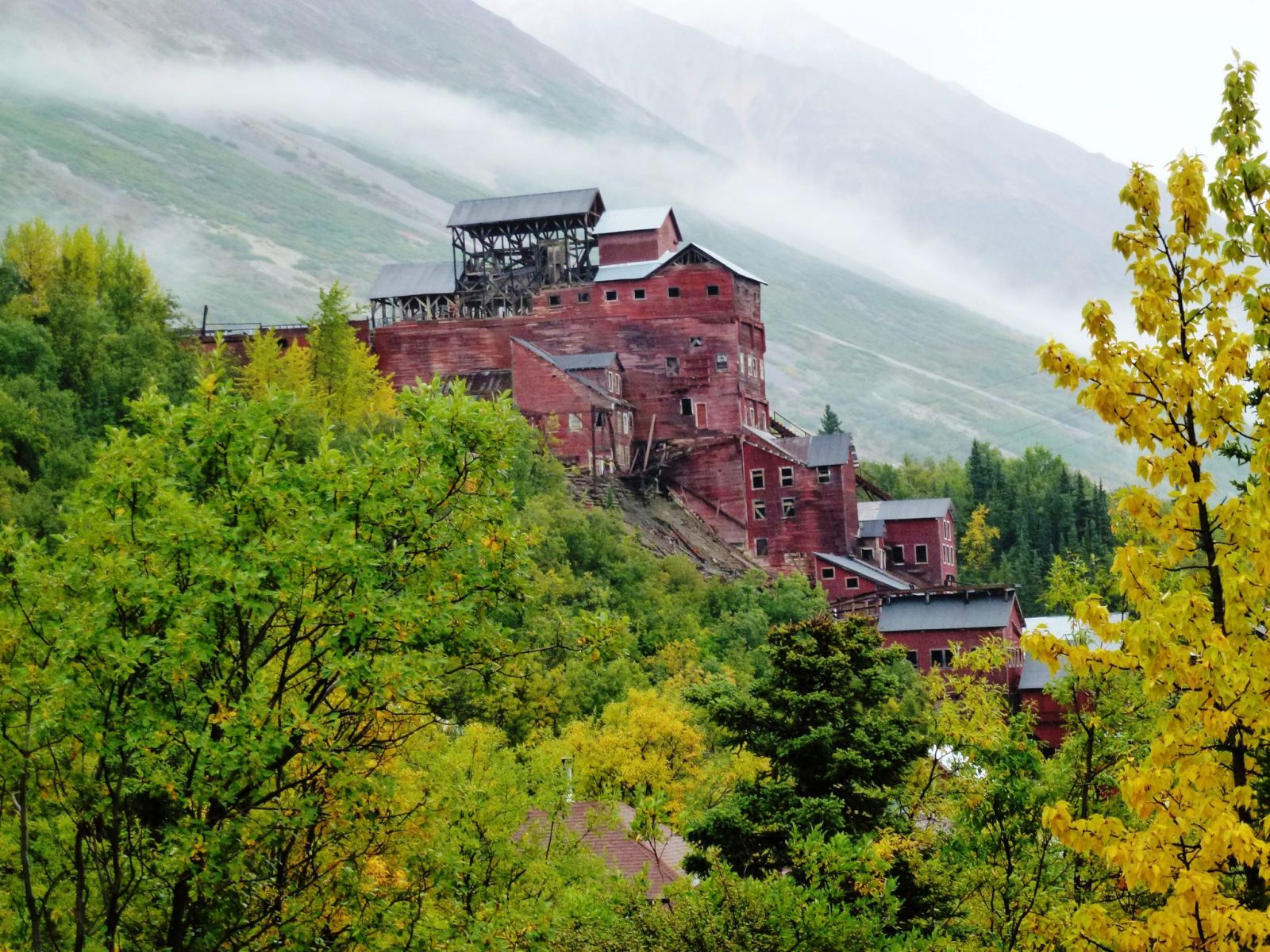
Photo Credit: Jamie Volz
Camping and Lodging in Wrangell-St Elias
The Kennicott Glacier Lodge in the ghost town of Kennicott near McCarthy is the only lodging at the park. There are couple of lodging options in McCarthy.
There are a couple of campgrounds available along the McCarthy Road. In addition the national park service Jumbo Creek walk in campground is a favorite of many visitors. It has no amenities of any kind and is a 1.5 mile walk from Kennicott.
Backcountry camping is also an option in Wrangell-St Elias.
Wrangell-St Elias Highlights
- Ahtna Cultural Center and Copper Center Visitor Center – Both are located at Park headquarters which is in Copper Center, near Glenallen. This is a great place to get started learning about the park and getting the latest conditions. You can also explore overlooks and lookout trails here.
- Hiking the Root Glacier Trail – This phenomenal day hike is just under 5 miles round trip with 150 feet of elevation gain along the side of Root Glacier from Kennecott Mine. You can make it a longer hike up to even more mountain views and some old mining equipment if you’re looking for a longer outing. You can even go out and hike on the glacier with a guide. I don’t recommend glacier travel without a guide unless you are very experienced in glacier travel. If you go on a guided tour they give you crampons to wear and show you how to use them so you can safely explore the ice.
- Kennecott Mines National Historic Landmark – explore the visitor center and restored ghost town buildings for the Kennecott copper mine against a mountain backdrop
- Wagon Road/Toe of Kennicott Glacier – For a three mile round trip hike, you can explore the Wagon Road and see the toe and terminal morraine of Kennicott Glacier. You can walk the wagon road all the way to Kennecott if you want a longer outing or want to walk instead of taking the shuttle between McCarthy and Kennicott. You can also explore the toe of Kennicott Glacier by kayak on a kayaking tour, which is a really fun and unique experience.
- Flightseeing – if you’re short on time, or like flightseeing, epic mountain vistas will greet you from the air!
- There are lots of tours offered here if you want to get into glacier trekking or ice climbing.
Special Considerations for Wrangell-St Elias
The slow drive on the gravel park road (3 hours each way) makes it impractical for a driving day trip. If you are day tripping, take a local air taxi service and skip the road.
The majority of rental car companies do not allow you to drive their cars on gravel roads such as the McCarthy Road. If you want to drive yourself, try a local, independent car rental company and make sure that gravel road driving is allowed.
Sample 4 day Itinerary for Wrangell – St Elias
- Day 1: Travel to Wrangell – St Elias from Anchorage. If you’re driving, this will take all day so take your time! Get settled at the lodge or camping.
- Day 2: Guided hike to Root Glacier
- Day 3: Flightseeing and exploring the Kennicott Mine and other trails
- Day 4: Travel back to Anchorage, again, take your time!
Learn more: How to visit Wrangell-St Elias National Park – the Ultimate Guide
Katmai National Park and Preserve
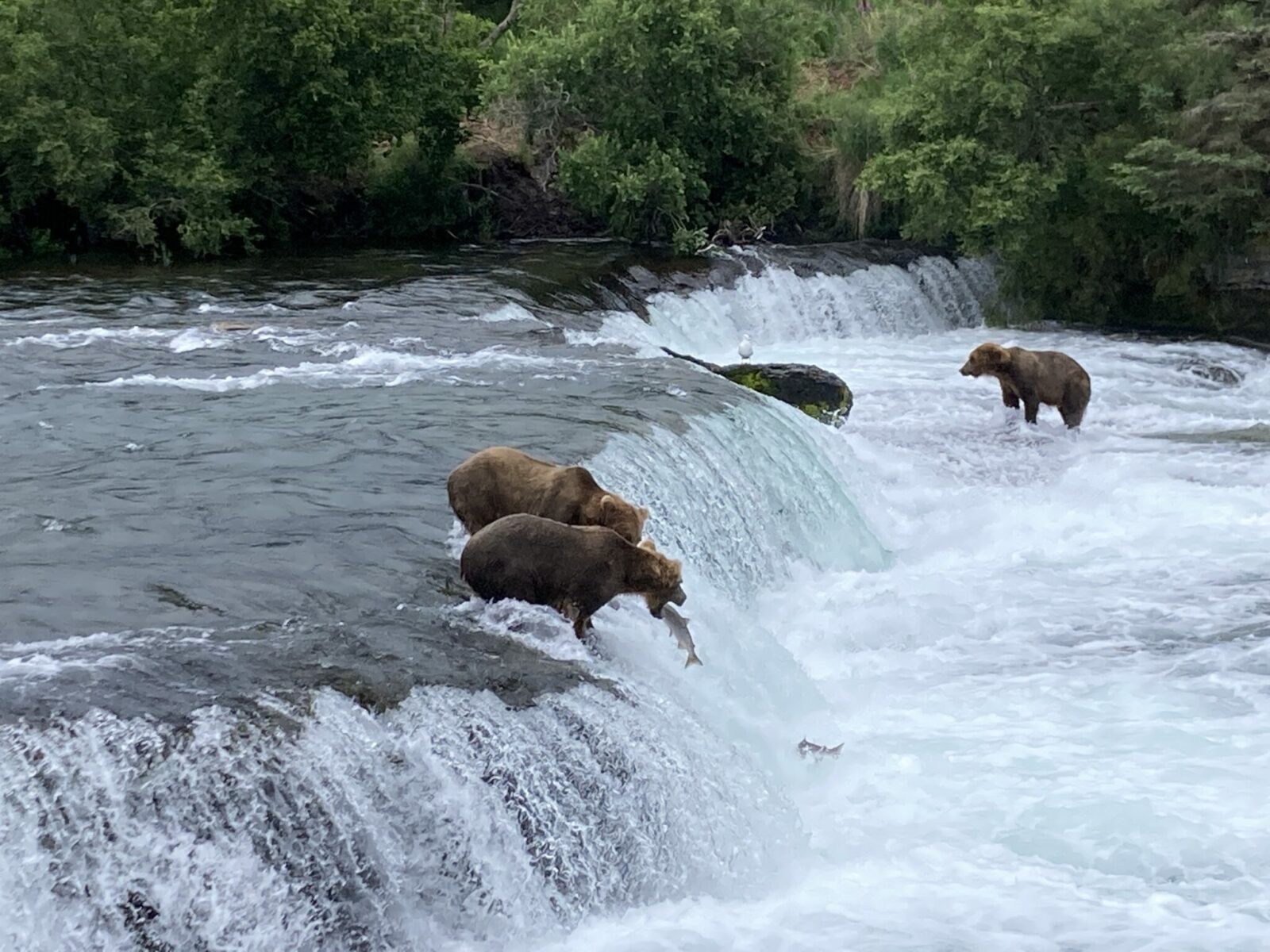
Katmai National Park is known for bears and it is probably the bear capital of North America! It’s not just amazing wildlife though. Katmai is also home to many active volcanoes including Novarupta, home to the largest volcanic eruption in the 20th century worldwide in 1912. Volcanoes build new land all the time, blow themselves up and meanwhile glaciers and ice erode that land away.
Katmai is the homeland of the Yup’ik and Alutiiq people.
Getting to Katmai National Park and Preserve
Katmai is one of the Alaska national parks that is not accessible by road and requires a flight on a small plane. First, you’ll need to make your way to Anchorage, King Salmon or Kenai and then you’ll get a small float plane to Brooks Camp. You can also fly there on a small plane directly from Anchorage.
There is no entrance fee for Katmai National Park.
When is the best time to visit Katmai?
Summer is the only practical time to visit Katmai. The bear viewing is best in July and September when salmon runs are happening. Even in this remote Alaska national park, Brooks Camp gets quite busy, especially with fly in day trips. If you’re looking to avoid crowds and have fewer bugs, go in September. Keep in mind that in September you’ll need to build in even more extra days for potential weather delays. July has more predictable weather, but it’s all relative! Being ready for rain and wind anytime of year is imperative in Katmai.
Camping and Lodging in Katmai
Overnight stays in Katmai National Park require a lot of advance planning as there are only two options other than backpacking and both are very hard to get reservations for and need to be done 6 months ahead (camping) and 18 months ahead (lodge). Even with planning ahead, securing a spot in either is no guarantee until you have it in hand.
The Brooks Camp campground must be reserved in advance and has room for 60 campers. They also have a bear fence, cooking shelters and a food cache for storing food, cooking supplies and toiletries. The Brooks Camp campground fills in a couple minutes for the entire summer when permits become available (usually in early January) so you’ll need to plan ahead for this one.
It is also possible to backcountry camp in Katmai if you have extensive backcountry experience including very remote travel, river fords and off trail travel.
The Brooks Lodge has very expensive rooms for those who don’t want to camp. They also serve buffet meals three times a day. The Lodge is reserved by a lottery 18 months in advance (usually December a year and a half before the season).
Katmai National Park Highlights

- Brooks Falls – most visitors to Katmai come for the world famous bear viewing from the platforms over Brooks Falls. When salmon are running bears congregate here for fishing.
- Valley of 10,000 Smokes – This unique volcanic landscape was most recently shaped by the Novarupta eruption in 1912. A bus tour for a day trip from Brooks Camp to this remarkable and impressive landscape.
- Ranger led cultural walk – learn about the archaeology of the Brooks River, one of the most concentrated archaeology areas in North America.
- Fishing – world famous fishing is available in Katmai, both on your own and with a guide
- Flightseeing – incredible flightseeing for bear viewing as well as the volcanic landscapes of Katmai are available in the park as well as from Kodiak and King Salmon.
- Backpacking – experienced backcountry travelers can do an epic backpacking adventure in Katmai! If you’re interested in this, read my friend Molly’s series of posts about her trip through Katmai.
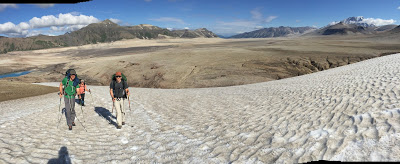
Photo Credit: Molly Odell
Special Considerations for Katmai
Plan extra days into your itinerary to account for the possibility of cancelled small plane flights due to weather.
You will also need to bring everything with you to Katmai as there are no groceries available in the park.
Bears rule in Katmai. All visitors are required to participate in “bear school” on arrival, which includes a video and briefing from the park service on bear safety. In Katmai, the bears go where they want and it’s the people who need to get out of the way!
Be ready for rain and wind all summer while visiting Katmai.
Unless you plan far ahead and also get lucky with camping reservations or the lodge lottery, you’ll be looking at a day trip.
Sample 3 day Itinerary for Katmai
Most people will be doing a day trip from Anchorage and the tour operator will set the itinerary. But if you’re lucky enough to snag a campsite or spot at the lodge:
- Day 1: Travel to Katmai and get settled. Explore Brooks Falls and see the bears!
- Day 2: Take the tour to the Valley of 10,000 smokes
- Day 3: Flightseeing and/or fishing, visit the bears again before returning to Anchorage or King Salmon for the night
Learn more: How to visit Katmai National Park: Ultimate Guide
Lake Clark National Park and Preserve
Lake Clark National Park is another Alaska National Park that is in a remote roadless wilderness. A land of volcanoes and glaciers, like Katmai and much of Alaska and the Pacific Ring of Fire, these volcanoes constantly build mountains while also blowing themselves up from time to time. Meanwhile glaciers both past and present, grind down the land to fine silt.
Lake Clark is the homeland of the Dena’ina Athabaskan people.
Getting to Lake Clark National Park and Preserve

Getting to Lake Clark National Park involves a flight in a small plane. It’s important to research your options depending on where you want to go and where else you are going on your trip in Alaska. For most people, a day trip from Anchorage to Crescent Lake is the most economical and efficient way to do it, especially if you’re planning to go to multiple parks in one trip and aren’t interested in camping.
There are wheeled planes that take you to beaches and gravel bars, or float planes that take you to lakes.
You can fly out from Anchorage, or you can fly from several other smaller communities, such as Kodiak, King Salmon, Homer, Kenai, Soldotna or Port Alsworth.
There is no entrance fee for Lake Clark National Park and Preserve.
When is the best time to visit Lake Clark?
Like most of Alaska National Parks, Lake Clark is best visited in the summer and fall. Tour operators and lodges are in full swing June through September.
If you’re doing a bear viewing flight from Anchorage, I recommend September – lots of bears and gorgeous fall colors!
Camping and Lodging in Lake Clark National Park
There are no organized campgrounds in Lake Clark, but in general camping is allowed in most areas unless they are closed for a specific reason. Connect with the park directly or with your flight operator for good options for camping in Lake Clark.
There are a number of private lodges operating here, most oriented around fishing which is superb in this area. They will help you connect with an air service to get you to their remote locations. The Farm Lodge is an excellent option that has packages to spend time in different parts of Lake Clark National Park, and you can do a combo package to fly into Katmai as well.
Lake Clark Highlights
- Port Alsworth Visitor Center – get oriented to the park and learn about it’s natural and cultural history
- Dena-ina Fish Cache – learn all about the long history and present day importance and techniques for subsistence fishing
- Tanalian Falls Trail – one of the very few developed hiking trails in Lake Clark, this trail from Port Alsworth is 7.5 miles with 1200 feet of elevation gain, featuring a waterfall as well as views of the lake.
- Wildlife – Bears are frequent in the park and there are an astounding number of birds. I love the day trip from Anchorage that goes to Crescent Lake for bear viewing
- Kayaking or Canoeing – it’s tricky to bring your own since you’ll be flying on a small plane. Consider renting or taking a guiding trip when you arrive. An inflatable boat may be able to travel with you, but check with your air carrier to find out
- Fishing – fishing is world class in this area!
Special Considerations for Lake Clark
The most important thing to consider for Lake Clark is it’s remote location and similar to other parks, the impact of weather on small plane flights. Build some flexibility into your schedule to account for this.
Similar to many other Alaska National Parks, Lake Clark does not have any services, developed trails or campgrounds. There are also no grocery stores in Port Alsworth so you’ll need to bring everything with you that you’ll need for your trip, unless a guide or lodge is providing supplies.
Sample itinerary for Lake Clark
If you want to spend time in Lake Clark, you’ll need to work with a small plane operator to coordinate drop off and pick up. They can help you plan your itinerary based on where you want to go and what you want to do!
Gates of the Arctic National Park and Preserve
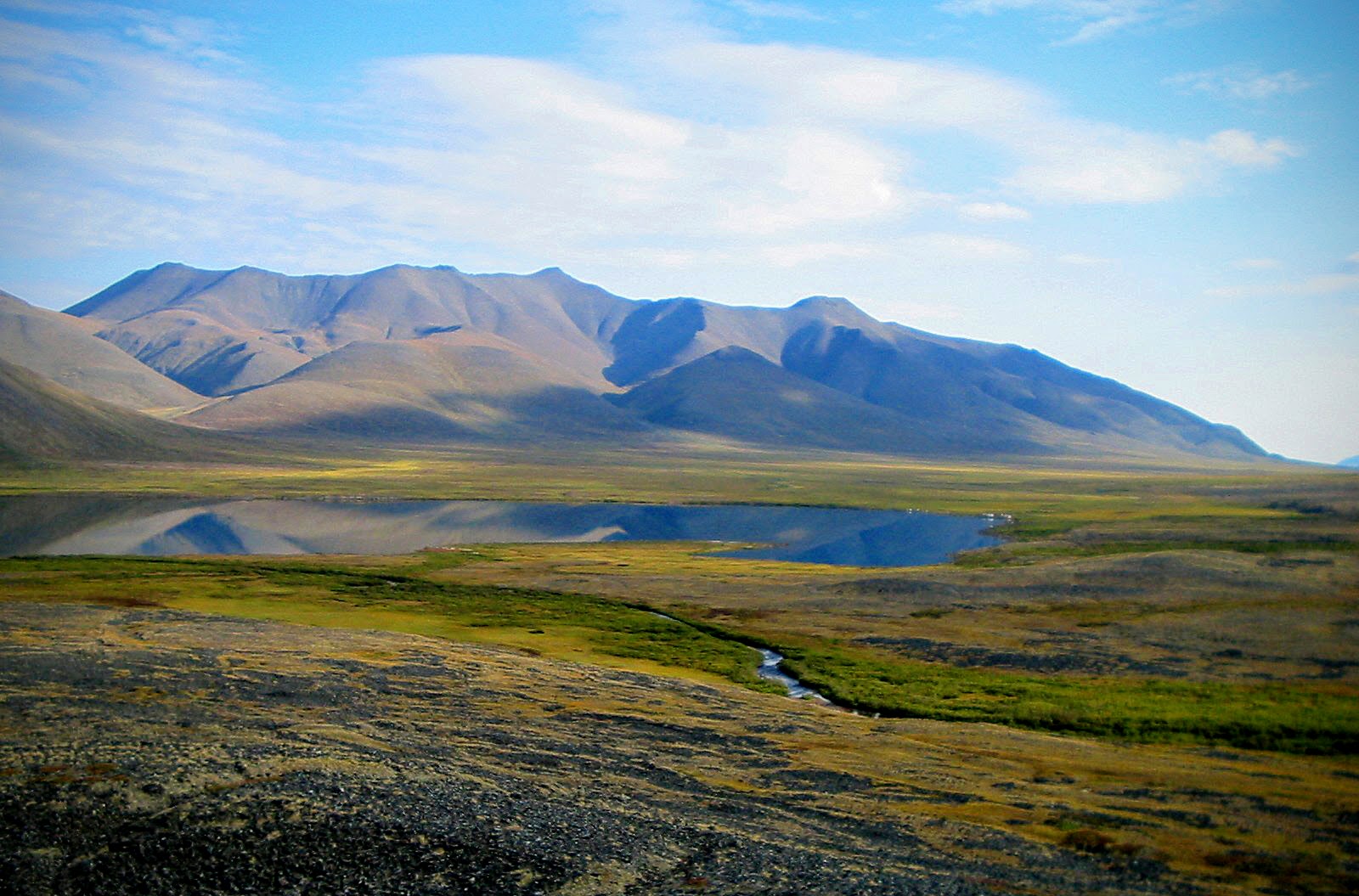
Photo Credit: Jay Flaming
My husband, Jay, spent several summers doing archaeology field work in Gates of the Arctic National Park and I am one of the lucky people who’s had the opportunity to visit this remote Alaska National Park and get to meet some of the people who live there. Gates of the Arctic is one of the two Alaska National Parks above the arctic circle.
If you really want to visit every Alaska National Park, one way to visit Gates of the Arctic is a flightseeing trip from Bettles. You can also do a day trip from Kotzebue with a brief stop in both Gates of the Arctic and Kobuk Valley! Keep in mind that poor weather can ground planes any time of year, so give yourself a few days to explore Bettles or Kotzebue and increase your changes of good weather for your flight.
Gates of the Arctic National Park is the homeland of the Nunamiut people, the most recent hunter gatherer people in North America. The Nunamiut practiced an exclusively subsistence life here until the middle of the 20th century. Today, Nunamiut subsistence is a big part of this national park.
Getting to Gates of the Arctic National Park and Preserve
The shortest way to get to Gates of the Arctic National Park is to fly from Fairbanks on a scheduled air service to the very small town of Bettles, which takes just over an hour on a small plane. From there, you can charter a float plane to drop you off in Gates of the Arctic National Park on a remote lake! You can also meet up with guides here for multiday backpacking or rafting adventures or do a flightseeing tour.
If you’re combining a day trip of flightseeing with Kobuk Valley, you will probably leave from Kotzebue instead (fly there from Anchorage).
There is no entrance fee for Gates of the Arctic National Park and Preserve.
When is the best time to visit Gates of the Arctic National Park?
It is really only possible to access Gates of the Arctic in July! Though the exact timing of “summer” varies from year to year, but lakes may not break up for float planes to land until the very end of June. Generally, Fall arrives bringing snow and lakes beginning to freeze up at the very beginning of August.
Camping and Lodging in Gates of the Arctic
There are no lodges or accommodations in Gates of the Arctic National Park. There are also no developed campgrounds. Connect with the air service to coordinate where you want to go, and they will have ideas for you about good places.
Gates of the Arctic Highlights
- Flightseeing can be a great way to see the park for a brief or casual visitor; flightseeing to Kobuk Valley and Gates of the Arctic in one trip is a possibility
- Guided trips are available including ones with a combination of Gates of the Arctic and Kobuk Valley with a combination of rafting and hiking
- Brooks Range – the northernmost stretch of the Rocky Mountains and the most northern part of the Continental Divide
- Wildlife – bears and caribou in particular roam the park
- Epic Alaska Scenery – mountains, river, tundra, it’s all here and extremely remote
Special Considerations for Gates of the Arctic National Park
The most important considerations for Gates of the Arctic National Park are it’s extreme remoteness and very short season. There are no roads, services, campgrounds or scheduled transportation into the park. Traveling into Gates of the Arctic should only be attempted by those experienced in backcountry travel and/or as part of a guided trip. You will need to bring everything you need with you as there are no places to buy any supplies.
Keep in mind that poor weather can ground planes any time of year, so give yourself a few days of flexibility in your trip and increase your changes of good weather for your flight.
Sample Itinerary for Gates of the Arctic
If you’re up for a multi day guided backpacking or rafting trip, work with a tour operator to organize your flights and drop off and pick up.
If you’re not into that, you’ll be making a day trip from Kotzebue. You can combine this with a flightseeing trip to Kobuk Valley as well and land to walk around in both.
Kobuk Valley National Park and Preserve
Kobuk Valley is one of the very remote and roadless Alaska National Parks, located in northwestern Alaska. This remote park does not charge an entrance fee and no reservations are required (unless you’re with an organized tour group or guide).
If you really want to visit every Alaska National Park, similar to Gates of the Arctic, one way to visit Kobuk Valley is a flightseeing trip from Kotzebue. You can even do a day trip from Kotzebue with a brief stop in both Kobuk Valley and Gates of the Arctic! Keep in mind that poor weather can ground planes any time of year, so give yourself a few days to explore Kotzebue and increase your changes of good weather for your flight.
Kobuk Valley is the homeland of the Inupiat people.
Getting to Kobuk Valley National Park and Preserve
Kobuk Valley is in remote northwestern Alaska, north of the arctic circle. The park headquarters and visitor center is in the small and remote town of Kotzebue.
To get into the park itself, first you need to get yourself to Kotzebue, which is about an hour and 45 minute flight from Anchorage.
Once in Kotzebue, you can either do a flightseeing trip over the park, or you can be dropped off for a backcountry backpacking or rafting trip. There are guides and tours available, which must be arranged far in advance. No one should attempt to head into the park on their own without extensive backcountry experience as there are no services and no way to communicate without a satellite phone.
There is no entrance fee for Kobuk Valley National Park and Preserve.
When is the best time to visit Kobuk Valley National Park?
Even in summer, Kobuk Valley is remote and rarely visited. Winter visitors must be very experienced and prepared for winter survival.
The best time to visit is mid June through mid August. June and July have lots of bugs, in August there are more berries and less bugs, but it is usually colder. Summer temperatures are generally in the 60s, but can be below freezing any time of year and can also get quite warm at times. The sun does not set at all in June and early July, and only dips briefly below the horizon the rest of July.
Camping and Lodging in Kobuk Valley
There are no campgrounds in Kobuk Valley and no trails. Backcountry travelers can camp in the backcountry if backpacking or rafting.
There are a few hotels available in Kotzebue, but not in the park.
Kobuk Valley Highlights
- Northwest Arctic Heritage Center – Kobuk Valley’s visitor center is located in Kotzebue
- Flightseeing can be a great way to see the park for a brief or casual visitor; flightseeing to Kobuk Valley and Gates of the Arctic in one trip is a possibility
- Wildlife watching – especially for Caribou crossing the rivers!
- For those with extensive backcountry experience, rafting or backpacking
- Stunning Alaska scenery of the Kobuk River Valley
- Great Kobuk Sand Dunes – created by the grinding of glaciers making rock into powder, these impressive dunes are whipped up by the frequent winds to impressive heights.
- Guided trips are available including ones with a combination of Gates of the Arctic and Kobuk Valley with a combination of rafting and hiking
Special Considerations for Kobuk Valley National Park
Like Gates of the Arctic, Kobuk Valley National Park is extremely remote and has a very short season. There are no roads, services, campgrounds or scheduled transportation into the park. Traveling into Kobuk Valley should only be attempted by those experienced in backcountry travel and/or as part of a guided trip. You’ll need to bring everything you need with you from Kotzebue.
Kobuk Valley National Park has fierce mosquitoes in June and July!
Keep in mind that poor weather can ground planes any time of year, so give yourself a few days to explore Kotzebue and increase your chances of good weather for your flight.
Sample Itinerary for Kobuk Valley
Similar to Gates of the Arctic and Lake Clark, if you’re up for a multi day guided backpacking or rafting trip, work with a tour operator to organize your flights and drop off and pick up.
If you’re not into that, you’ll be making a day trip from Kotzebue or possibly Bettles. You can combine this with a flightseeing trip to Gates of the Arctic.












